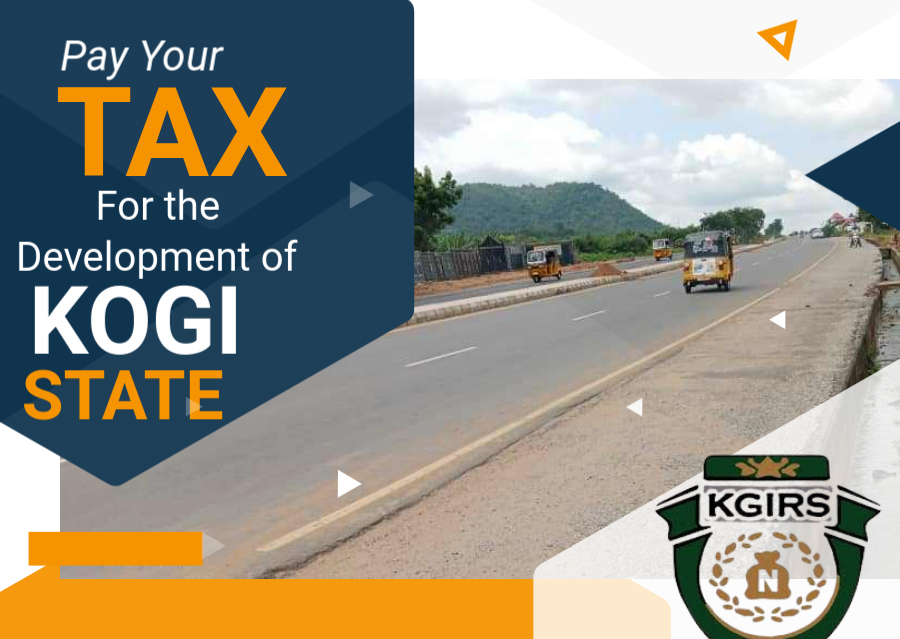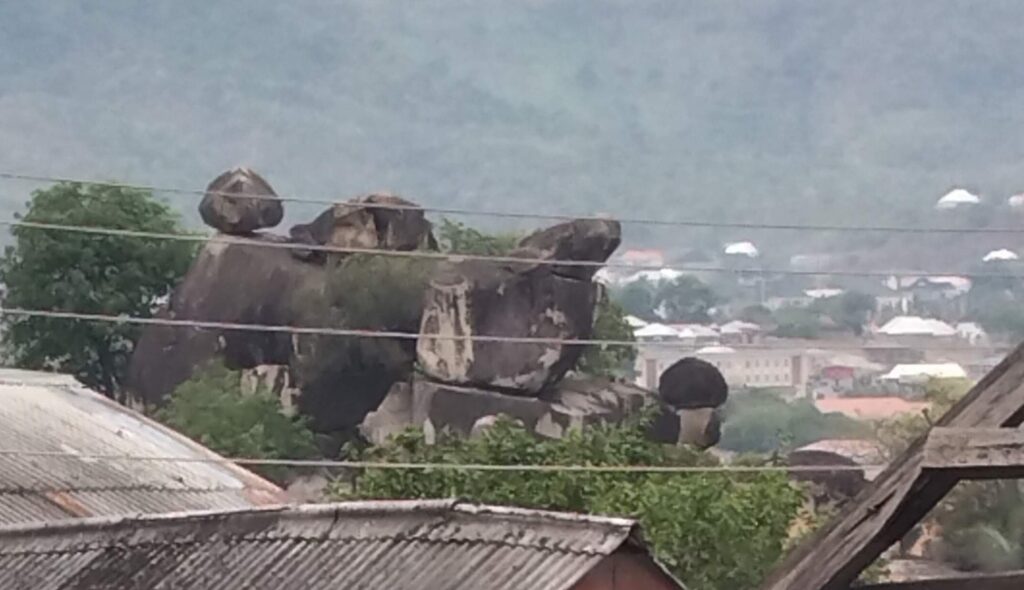

By Dada Ahmed.
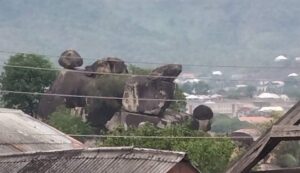
One of the tourism attractions in Lokoja waiting for tourists’attraction.
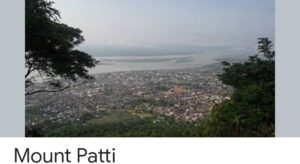 The mountain, which is 1,500 feet above sea level, overseeing the site where River Niger and Benue and form confluence in Lokoja.
The mountain, which is 1,500 feet above sea level, overseeing the site where River Niger and Benue and form confluence in Lokoja.
Photo credit:en.m.wikipedia.org
For many first-time visitors to Lokoja, the capital of Kogi State, the city elicits some kind of excitement as the location where Rivers Niger and Benue, Nigeria’s two most prominent rivers meet and flow peacefully as one indivisible entity.
The confluence of the two rivers aptly explains why Kogi State is generally referred to as “the confluence state”.
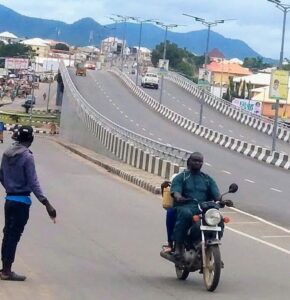
The first flyover in the history of kogi state,a geo-political expression on August 27,1991 built by Governor Bello Yahaya Adoza Bello.
The confluence, which is widely recognised for its tourism potential, is figuratively described by some observers as the “heart of Nigeria’’ because of its geographical location in the country.
However, Abraham Onotu, a tourism expert, is quick to point out that the confluence of the Niger and Benue rivers at Lokoja is not the only significant tourist attraction in Kogi State.
“Besides the rivers’ confluence site, Kogi State has the latent possibility of becoming a tourist destination to millions of tourists within Nigeria and from overseas,” he says.
Onotu insists that the potential tourism sites in Kogi are numerous and capable of turning the state into a quality tourist retreat in the country,if such potentiality is effectively harnessed by the private and sectors of the economy for the benefit of its citizens.
He says that Kogi State can be aptly described as “a state waiting to take its pride of place in the Nigerian tourism industry, in view of its abundant tourist attractions’’.
Onotu calls on the state government to champion the drive to exploit the potential tourism resources of Kogi in collaboration with the private sector.
However, that is not to suggest that tourists are not aware of the tourism treasures of Kogi, as sharp-eyed tourists have been visiting the state in their leisure time.
For instance, Miss Bridget Thomas, a Briton, is one of such tourists who once visited Lokoja’s dormant tourism sites.
Bridget’s primary destination was the residence of Lord Fredrick Lugard, Nigeria’s first Governor-General who spearheaded the amalgamation of the northern and southern protectorates of Nigeria in 1914.
The edifice, now within the premises of the Nigeria Union of Journalists (NUJ) Press Centre and records indicate that it was one of the quarters of senior officials in the colonial regime now serves as a relaxation spot for journalists and other members of the public.
Tourist enthusiasts say the historic edifice is a shadow of itself and in dire need of serious structural uplift as part of effort to preserve the colonial legacies abundant in Lokoja,one time capital on colonial government in Nigeria.
On the day, a British national, Bridget visited the colonial staff quarters, she met some journalists wining and dining at the recreation spot and she promptly disclosed her mission.
“I am the great-grandchild of a colonial administrator who lived in Lokoja in the 1920s,’’ she said, adding: “I am here to conduct research into colonial artefacts in Lokoja, with particular reference to the building where my great-grandfather lived in those days.’’
Bridget carried out a guided tour of the building and after a 20-minute inspection; she excitedly called on the federal and state governments to develop the the edifice which the last major renovation was carried out in 1938.
This she believes will give the historic structure a befitting face lift and its adjacent buildings with a view turning them into a tourist sites, because of their historical value to the history of colonialism in Nigeria.
“Since I came here, I have seen many potential tourism sites in Lokoja which could be developed to generate substantial revenue,’’ a visibly elated Bridget said.
Many tourism experts agree with Bridget’s sentiments, saying that Kogi State has many potential tourism sites that can be developed and marketed.
Onotu says that such sites include the locations where some slaves were freed from the clutches of slave merchants in the 18th and 19th centuries, the spot where the flag of the Royal Niger Company was lowered in 1900 and the Rest House of Lord Lugard on top of Patti hill.
Others tourism sites, according to another tourism advocate, Peter Duniya, include the Lokoja Club that was built in 1901 by Lord Lugard, the “European Cemetery’’ in Lokoja, which contains the tombs of some European soldiers and African soldiers of the West African Frontier Force (WAFF), as well as tombs of some 17th Century missionaries.
Duniya says that some other sites with enormous tourism potential include the cenotaph that was erected in remembrance of British and Nigerian soldiers who died during the 1914-1918 first World War and the 1939-1945 second World War.
The cenotaph, erected on the Murtala Mohammed road in Lokoja, has a massive concrete slab displaying names of some soldiers who died during the two world wars, among other features.
The list of potential tourism sites in Lokoja appears endless. There is the first primary school in northern Nigeria, established in 1864 by missionaries under the aegis of Bishop Ajayi Crowther, the first African Anglican Bishop in Nigeria, as well as the military hospital and the prison — all trailblazers in the northern part of the country.
Outside Lokoja, the potential tourist destinations include; the red-brick palace of the Ohinoyi of Ebiraland,Dr. Ado Ibrahim, the rocky Agbaja Plateau, the Okene waterworks built in 1937, and the statue of Princess Inikpi at Idah market, erected in memory of the princess who according to oral traditions, was buried alive to save the Igala kingdom from an imminent defeat during the Jukun-Igala wars of the 19th century.
Duniya says that these potential tourism sites, among others, have placed Kogi in an advantageous position to become a major tourist haven in the country, if developed to attract local and foreign tourists.
He nonetheless insists that factors limiting the attainment of that vision include the absence of a proper policy framework to facilitate pragmatic development of the latent tourism sites and the seeming apathy of private-sector organisations towards tourism development in the state.
Another tourism enthusiast, Mr John Taiwo, called on the Yahaya Bello-led administration to develop much interest in harnessing the tourism potential of kogi state.
He called on the stake holders in the private sector, such as the Kogi State Chamber of Commerce, Industry, Mines and Agriculture (KOCCIMA) to forge Public-Private Partnership (PPP) arrangement with the state governent in exposing tourism resources of the state to the world.
“By that, potential or prospective investors will be propelled to develop interest in investing in the tourism potential of the state,”he argues.
Taiwo stressed the need for the government to galvanise members of the private sector toward the need to stimulate the socio-economic development of the state, a development he hopes would encourage them to invest in the state’s tourism resources as well.
He also imploresld the state government to evolve a purposeful policy that would encourage private-sector agencies to participate in tourism development projects of the state.
Another tourist, Mr Zubair Yusuf,believes that: “Government tourism policy could also focus on the provision of good roads, ensure Improved security, stable electricity and potable water, particularly in areas where the tourism sites are located while offering tax reliefs to entrepreneurs willing to invest in the state’s tourism industry.
“Besides, the state government should guarantee the security of the tourism sites and that of potential tourists.
” When governent does this, efforts to develop the state’s tourism industry will appear to be on track, and goes along way to market the rich tourism potential of the state to prospective foreign and local investors.
” Realising the fact that tourism is a veritable source of revenue generation, the current administration must take some pragmatic steps to harness the state’s tourism potential via various promotional and development programmes.
” In this case,the Ministry of Culture and Tourism should be in the vanguard of actualising this dream by producing some promotional materials such as handbills which display the state’s tourist destinations as part of efforts to provoke the patronage of prospective tourists.
“The state should also ensure be consistency in participating in various Carnivals as part of of efforts to sell its rich tourism potential to the world and attract tourists,’’ he says.
“Government should make conscious effort to complete the five-star hotel in Lokoja to boost the hospitality industry and attract more tourists’’.
“The private sector, especially affluent citizens of the state, should start to invest in the state’s tourism industry because there is every possibility and assurance that with serious committeement of public and private sectors to this potentially money-spining industry, they will get good returns on their investment.
Generally,tourism analysts are of the strong belief that if concerted efforts are genuinely made to develop the dormant tourism industry of Kogi State, either by the state government or members of the private sector, the state will become a Mecca or Dubai for tourists, in and outside the shores of Nigeria.
They also argued that the effort would go along way to boost wealth creation,pave way for increased revenue and enhance the culture and traditional to the world.
According to them,the move if given the desired boost,will encourage foreign investors to join hands with the concerted process to invest in tapping the hidden natural resources of the state for meaning social and economic development for and sundry
Dada Ahmed, a member of the Nigerian Guild of Editors,NGE,punishes The Reporters.
